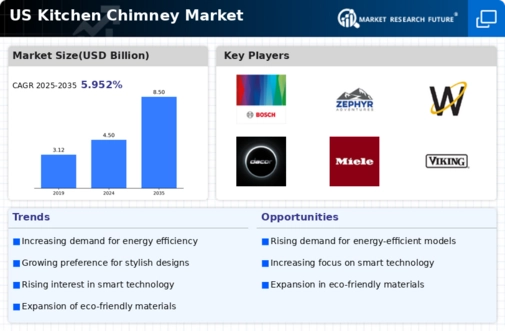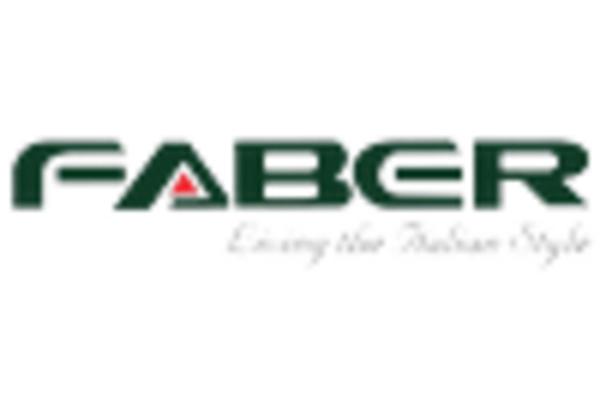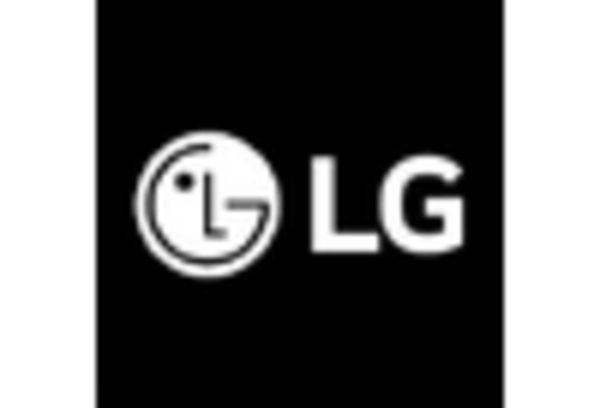Rising Consumer Awareness
The kitchen chimney market is experiencing a notable increase in consumer awareness regarding indoor air quality and the health implications of cooking fumes. As more individuals recognize the potential health risks associated with poor ventilation, the demand for effective kitchen chimneys is likely to rise. Recent surveys indicate that approximately 65% of homeowners in the US prioritize air quality in their kitchen environments. This heightened awareness is driving consumers to invest in advanced kitchen chimney solutions that not only enhance air quality but also contribute to a healthier living space. Consequently, manufacturers in the kitchen chimney market are focusing on developing products that meet these evolving consumer expectations, thereby fostering growth in the industry.
Technological Integration
The integration of smart technology into kitchen appliances is becoming a defining feature of the kitchen chimney market. Consumers are increasingly seeking products that offer convenience and enhanced functionality, such as remote control operation and integration with home automation systems. Recent market analysis suggests that the segment of smart kitchen chimneys is projected to grow by approximately 25% over the next five years. This trend indicates a shift towards more sophisticated kitchen solutions that cater to the modern consumer's lifestyle. As manufacturers continue to innovate and incorporate advanced features into their kitchen chimneys, the market is likely to expand, attracting tech-savvy consumers who prioritize efficiency and ease of use.
Urbanization and Housing Trends
Urbanization continues to shape the kitchen chimney market, particularly in metropolitan areas where space is often limited. As more people move to urban centers, there is a growing trend towards modern housing solutions that incorporate efficient kitchen designs. The National Association of Home Builders reports that around 80% of new homes in urban areas are being built with open-concept kitchens, which necessitate effective ventilation systems. This trend is likely to propel the demand for kitchen chimneys, as homeowners seek to maintain a pleasant cooking environment. Additionally, the kitchen chimney market is expected to benefit from the increasing number of renovations and remodels in urban settings, further driving sales and innovation in the industry.
Aesthetic Appeal and Customization
There is a growing demand for aesthetically pleasing and customizable products in the market.. As kitchens become central to home design, consumers are increasingly looking for kitchen chimneys that complement their interior decor. Recent studies indicate that around 70% of homeowners consider design as a crucial factor when purchasing kitchen appliances. This trend is prompting manufacturers to offer a wider range of styles, colors, and finishes, allowing consumers to personalize their kitchen spaces. The emphasis on aesthetics, combined with functionality, is likely to drive growth in the kitchen chimney market, as consumers seek products that not only perform well but also enhance the overall visual appeal of their kitchens.
Government Regulations and Standards
The kitchen chimney market is influenced by various government regulations aimed at improving indoor air quality and energy efficiency. Regulatory bodies in the US are increasingly implementing standards that require kitchen ventilation systems to meet specific performance criteria. For instance, the Department of Energy has established guidelines that promote energy-efficient appliances, which include kitchen chimneys. Compliance with these regulations not only enhances consumer safety but also encourages manufacturers to innovate and improve their product offerings. As a result, the kitchen chimney market is likely to see a surge in demand for compliant products, as consumers become more aware of the benefits associated with adhering to these standards.

















Leave a Comment